For more than 20,000 years humans have used dogs to hunt all kinds of game. Today, it is no different. Using dogs can make us much more efficient in our hunting and also greatly increase our success. We use hunting dogs for three main purposes: tracking, chasing and retrieving a large variety of animals. There are hundreds of dog breeds, and many of them assist us in hunting, one way or another. Choosing the right dog for hunting a specific game animal can be the single most important decision you make when you start hunting with dogs. Here, I will lay out how we hunt different types of large game with dogs, as well as which breeds to choose, and how to train your dog to assist you in your hunt.
Types of Hunting Dogs
You need to realize that certain dogs are better are at particular tasks than others. Knowing which type and breed of dog you need for your hunt is the first and most important step. There are actually seven types/groups of dogs. These include terriers, toy, working, sporting, non-sporting, hound, and herding. As hunters, we use three of these groups: hounds, sporting, and terriers.
Hound dogs can be split up between sight hound dogs and scent hound dogs. Scent hound dogs are used to track animals. They have the best noses out of all dogs and normally hunt in packs to track and chase large animals. Sight hounds are solitary and chase smaller prey until they catch and kill it.
Sporting dogs can be further divided into gun dogs and catch dogs. Gun dogs are used to flush up and retrieve birds after the hunter shoots them. They are known for their ability to remember where birds are and fetch them on command. There are many breeds in this group, but some of the most popular are pointers and retrievers.
Catch dogs are normally used to hunt wild boar. They chase, and then catch/hold the boar until the hunter can get to it and dispatch the animal. For catch dogs, we generally use a bulker and more aggressive dog.
Terriers are very high energy and determined dogs. They will stop at nothing to get their prey. They dig into tunnels and chase vermin for miles until their harvest is complete.
Black Bear
How Do You Hunt Bear With Dogs
To start, you will need to scout out a general area that has signs of bear activity. When looking for an area with bear sign it is a good idea to look near common food sources. Bear tracks will be one of the first things to tell you a bear frequents the area. By looking at the tracks, you can get a good idea of how big the bear is. Generally, a track that is wider than five inches is an older large male. If you see bear tracks followed by smaller bear tracks you can confirm that it is a sow with cubs.
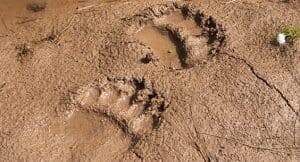
The next thing to look for is droppings. You can tell a lot about a bear’s diet from its droppings. What you see in the scat, for example, things like seeds or fruit skins can be one indication that the bears’ diet consists mainly of fruit.
The color of droppings can also tell you what a bear has been eating. Lighter color droppings are based on a mainly vegetarian diet while dark droppings are based on a carnivorous diet. Finding things like heavily scratched trees and generally chaotic scenes around food sources can also indicate that bears are in the area.
Once you have scouted an area to hunt your bear, the first thing you do is find a sample of a bear sign and allow the bear hunting dogs to smell it. After this, they pick up the scent and begin to follow it, eventually finding and chasing the bear. The chase can go on for miles and hours. Hunters are not normally able to keep up with their dogs so they use GPS tracking collars on their dogs. This allows them to follow the dogs more accurately than just by hearing the hounds alone.
The goal is to tire the bear out and get it to “tree”. To tree a bear means to get the bear to climb a tree in order to get away from the dogs. Although a bear does not always tree. Sometimes they will turn and face the dogs, this is not ideal and puts the dogs in more danger. Once the bear is stopped it is time to evaluate the bear and whether or not it will be harvested. This is when you will see if the bear is big enough to harvest or if it is a sow. You can tell a sow apart from a male by looking at its lactating nipples. If the bear is lactating, it is a sow.
Choosing The Breed of Your Bear Hunting Dogs
When you are hunting bears with dogs you will need a pack of dogs. For the general safety of you and the dogs, there is a minimum to your pack size. The minimum number of dogs you are required to have in your pack according to United States federal law is 6. Generally, the more the merrier, so 8-12 dogs is a good range.
Many types of dogs are specifically bred to hunt bears. However, the most common dogs used in America for bear hunting are hound dogs. Many different types of hounds can be used for bear hunting, and every veteran bear hunter will have their personal preference. Some examples of popular hound dogs used in bear hunting are the Bluetick, Walker, Redbone, and Plott hounds. Each of these dogs has its strengths and weaknesses, so most hunters will have more than one bread in their pack.
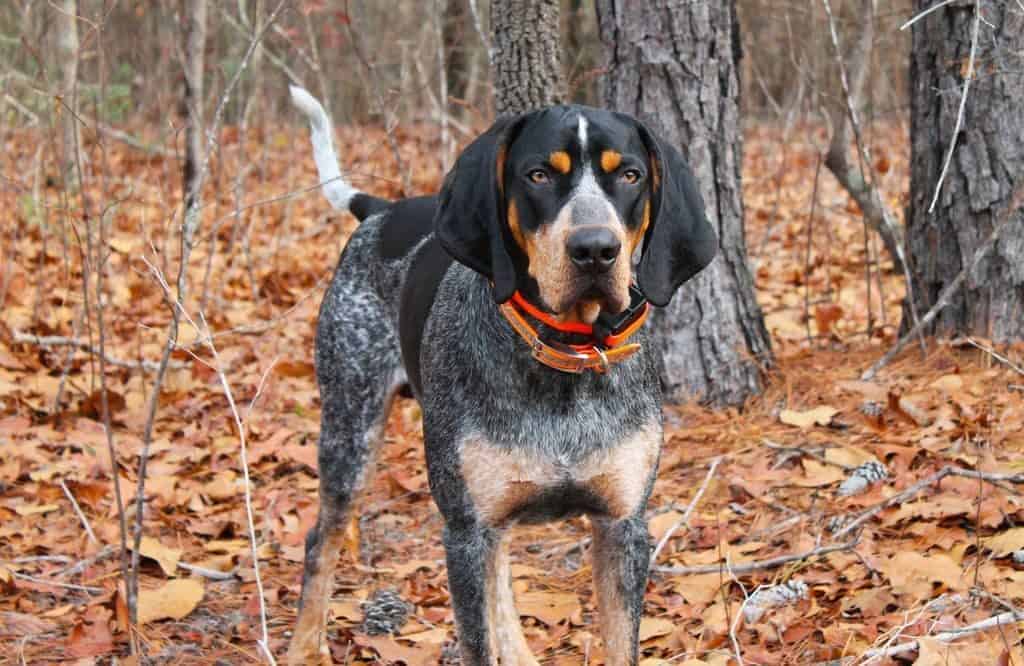
How To Train Your Dogs For Bear Hunting
When bear hunting, safety is a number one priority. The only way to stay safe is to have an obedient dog. Your dogs need to obey your every command during high-pressure situations. This way they will know when to chase, back off, and get out of the way. Your dog being able to obey your commands is the most important aspect of training, not only it is critical to success, but also to their survival. Bears are made to kill, so a single dog is no match for them.
Using a simple reward system during training will hammer in the idea of being obedient. When your dog fails or is not obedient, make sure to punish them harshly. This is different than a normal dog learning how to shake. If your dog decides he does not want to shake, the world keeps spinning, but if he does not obey you during a bear hunt he could very well die.
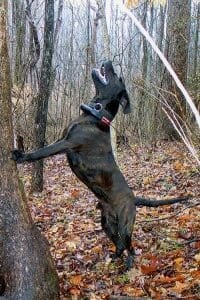
Your bear dogs need to be proficient in obedience, off-leash recall, and navigation. Your dogs need to be used to traveling in a kennel by truck. They should also be outfitted with GPS collars and be in a healthy state. Make sure you are feeding them plenty and giving them the exercise they require when you are not hunting.
To train your packs, in the United States where it is legal, you can practice on bears out of season. These are called training sessions. First, bait the bears and return later to pick up a bear trail. Encourage your pack along the trail while practicing recalling and directional commands. After a few sessions, the dogs will have a hang of it and may tree a bear. If this happens, recall your pack and leave the bear to escape.
You can also create your own bear trails with different products or bear parts. Create a trail and get your pack to follow it while you drag it. Once they have a hang of that, drag a trail without your dogs around and then bring them to the start of it. They should be able to pick up the scent and run with it. When the season starts you can begin to tree bears.
Wild Boar

Wild hogs are the most destructive animal on the planet. In the United States, they are constantly ruining farmland and grazing land for cattle. In just one year, they cause $1.5 billion worth of damage around the country. Hunters have gone to war with wild hogs for decades and use any and all tactics to eradicate them. When hogs destroy the land, not only are they taking money out of the farmers’ pockets, but they ruin local ecosystems at all levels.
Even with the efforts by farmers, hogs continue to lay waste to land because of their incredibly fast breeding. Harvesting 10-20 hogs a hunt may sound like a lot, but a single female shoat can be born and sexually mature in a short 6 months. After that she will have two litters per year, producing around 10-15 offspring per litter with a gestation period of just 115 days. Then those hogs will produce 10-15 more hogs in 6 months, you can see how quickly this gets out of hand.
How To Hunt Hogs With Dogs
To make sure this post brings you maximum value, I reached out to some professional hog hunting dog trainers to get the rundown of how they do things. A big thank you to TK Hog Dogs for helping me out on this segment of the article, check them out on Facebook.
Scouting for hogs is not that hard. Wild Boar will make a few different types of signs. First, look for wallows around water sources. Hogs wallow in the mud in order to cool down and protect themself from biting insects. Next, look for what we call “rubs”. A wild boar rub is when they rub themselves against trees, when they do this they will leave behind streaks of mud and sometimes hair.
As with any other animal, always look for tracks in the mud. Seeing tracks can give you a good idea of how many hogs are in the area and how often they frequent that location. The most important thing to look for is the destructive rooting that hogs do. This is why we hate them so much, they root up ground better than a farm plow. They do this to look for grubs and roots and are generally around field edges and farmland.
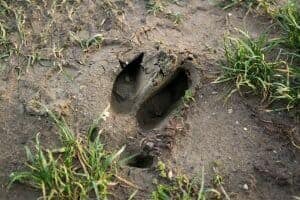
When using a dog to hunt for hogs, you need to use more than one hunting dog. Feral hogs can be very dangerous and cut dogs up very easily with their tusks. Generally using 5-10 dogs is a good range. Make sure the safety of your dogs is a top priority. You should be using GPS collars on all your dogs along with kevlar vests for your catch dogs to protect them from sharp hog tusks. Hog hunting is a dangerous game for dogs, they frequently get injured and can possibly die if not properly protected.
Once you have located the general area of your hogs, show the signs to the dogs. Well trained dogs will begin to follow the scent trail. The hunting dogs will then eventually find a hog or multiple hogs, and begin to chase them. The chase dogs will then bay up the hogs. After the hogs are bayed, then the hunter will send in the catch dogs. The catch dogs begin to hold them still by biting their ears. Generally, there will be a dog on each ear and other dogs continuing to bay the boar.
Then it is time for the hunter to approach, generally from the back, and grab a leg of the boar. This puts the boar in a position to be “stuck”. Many hunters that use dogs to hog hunt will opt not to use a firearm and instead use a knife to stab/stick the boar in the heart. This eliminates the possibility of accidentally shooting a dog. Although hog hunters do not always use a knife, depending on the situation they could opt to shoot the hog. There are hundreds of factors and no two hunts are ever the same, but generally, the idea is to stick the hog.
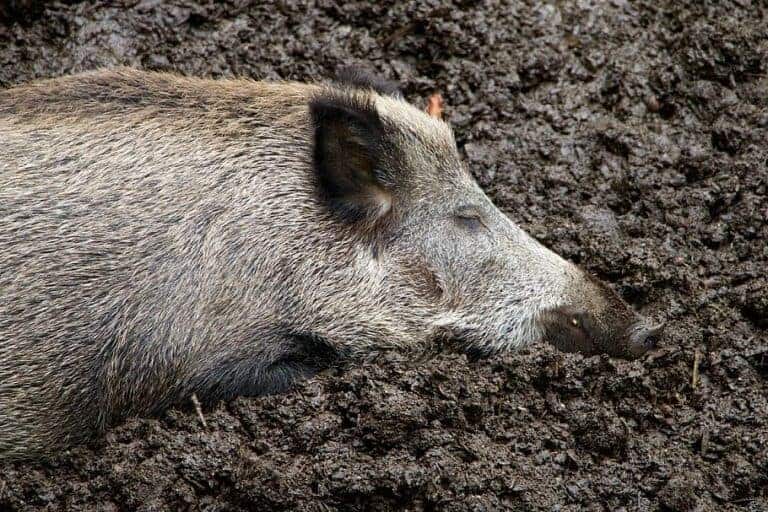
Choosing The Breed of Your Hog Hunting Dogs
You will need to select different breeds for your bay dogs, and catch dogs. For your bay dogs, you want something athletic, that can chase hogs for extended periods of time and catch up to them. Bay dogs generally have good noises for smelling out hogs and tracking them. Some of the most popular choices for hog hunting bay dogs are the Black Mouth Cur, Catahoulas, Redbone, Rhodesian Ridgeback, Walkers. Black Mouth Curs are some of the most popular, and for a good reason.
These dogs are working machines, they are also super smart and very athletic. They are the top choice for big-name hog hunters. Like the Black Mouth Cur, Redbones and Rhodesian Ridgebacks are strong dogs with athletic builds. The Walker is one of the most versatile dogs ever to exist. These dogs can do almost anything. They can smell out a boar with ease and bay it up quickly. Each dog has its own unique features so mix up your pack to include a variety of them.
For catch dogs, you need a large, mean, and muscular dog. Hunters normally use a bulldog breed for this task. Pitbulls are a popular choice, their strong bodies and determined nature can be a great match for the job. Although to take down the biggest of hogs some hunters suggest using American Bulldogs as your catch dogs. These dogs can weigh well over 100 pounds and have the edge when it comes to taking down 300-pound boars. When using a catch dog make sure they have kevlar vests. A hogs tusk can slice straight through a bulldogs’ thick muscle.
Advice from TK Hog Dogs, “Hunt behind as many different breeds and styles of dogs as you can, keep an open mind and don’t get tunnel vision. When you first start getting dogs, you may go through four different style packs before you finally settle and find what you want to hunt. This goes for both catch dogs and bay dogs. Stay patient, don’t rush, and pay attention to your dogs.”
RELATED POST: CAN HUNTING BE A JOB?

How To Train Your Dogs For Hog Hunting
Bay Dogs
When starting to train your dogs, you can either start them from scratch or mix them in with other more experienced hog dogs and hope the new guys catch on. Here is what TK Hog Dogs had to say about how they do it.
“Personally, we would rather start dogs from scratch. How you handle and hunt a dog can be night and day from how someone else handles and hunts a dog. It does not make their way better than yours, or yours better than theirs, just a different way of doing things. But starting a dog from scratch you learn all of the ins and outs of a dog, and the dog learns you from the beginning vs having to retrain one to your preference.
Once we get them started, we usually work our young dogs with our experienced dogs. If you do throw an experienced dog in the mix of a couple of young or new dogs, we pay just as much attention to the experienced dog as the young dogs, but a tad bit more to the young/inexperienced dogs. A young/inexperienced dog is more prone to make an error such as trashing, backtracking, etc. over the experienced dog. We run our dogs with a Garmin Alpha 100 & TT15 tracking/training system so if an error does occur and we are not right on top of them to correct it, we can correct it from afar.”
If you like the idea of starting your dogs from scratch and do not have other experienced hog dogs available, this is how TK Hog Dogs does it:
“We start ours in a pen on a smaller sized hog, something that will not hit the dog, but the dog can’t just bite/chew on the pig either. Let them get used to seeing a hog and smelling a hog. After that I would bring them in the woods as much as possible, tracks tracks tracks. As many fresh tracks as you can get them on the better. Some young dogs are leery of going out on their own, you may have to walk around with them a little through the brush. But the fresher the sign you get them on, in the beginning, the better.”
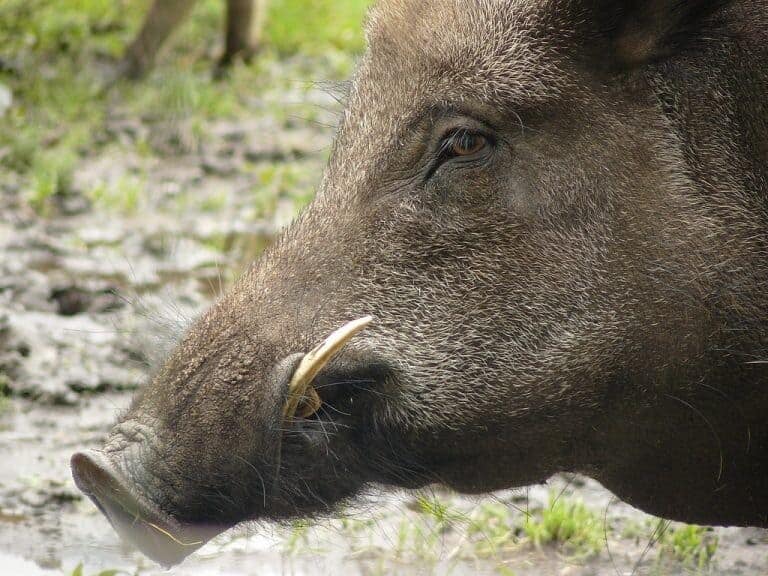
Catch Dogs
The job of a catch dog is to chase and “catch” a hog. They do this by biting at the ears or jaw of the hog and holding it in place until the hunter is ready to harvest the hog. Here is how TK Hog Dogs trains their catch dogs:
“We show all of our catch dogs a hog when they are around 5-7 months old. We personally are not believers in waiting until a dog is 15 months-2 years old to wait to see if the dog decides to turn on. Around 11-15 months we should already be able to use the dog. The age of the first introduction depends on the maturity level the dog is showing us at that time.
We look for them to show any type of interest at that young of an age. Things, like chasing the hog, catching, barking, and watching are good signs. Ideally, you really do not want to worry about starting them until they are close to a year. Around the 10 month mark, we personally like for them to already be catching. I would much rather have to pull on the reins and hold them back than have to push for them to go. A catch dog should want it naturally and already have that predatorial drive.”
How they start their training, “We start them on a hog that isn’t very rank that the dog can handle easily. We let them catch two or three times in a pen so it is a controlled environment, we want them to go for the ear or jaw ideally. Although some dogs go for the snout, which can be dangerous”.
Whitetail Deer
Using dogs for hunting is a controversial topic for many people. Non-hunters will be the first to condone the general use of dogs for hunting, but when it comes to deer drives many hunters are also against it. Decades ago deer drives were a popular form of whitetail hunting, due to their high success rate the whitetail population began to decline. To combat this, deer drives were deemed illegal in many states. Deer drives can also be a bad management strategy for private land. If you choose to use the deer drive method, know that you will be pushing deer out past property lines and that high pressure will keep them away for some time.
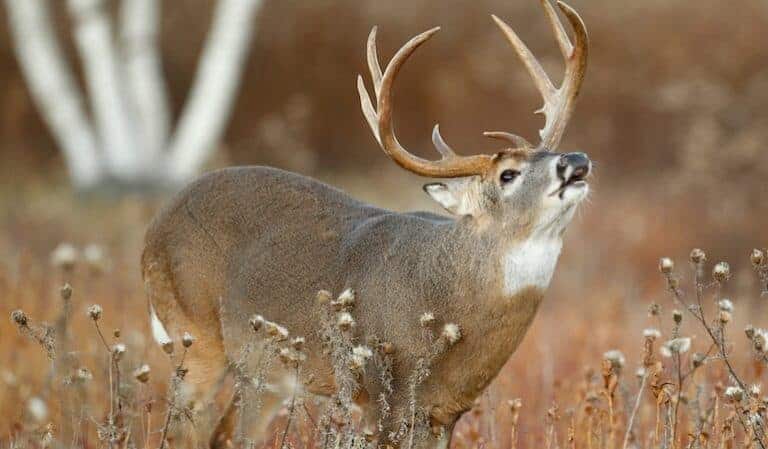
How Do You Do A Deer Drive With Dogs
Before you can hunt deer in any fashion, you need to scout the deer. There are many different guides on scouting deer, but here is a quick recap. Deer normally like hardwoods and thick brushed up areas. Normally hunters do deer drives in areas where it is mostly thick brush. This kind of terrain is harder to hunt with normal tactics. When you settle on a general area, look for deer sign. Things like deer tracks, deer rubs, scrapes, and droppings. Once you have located an area that is a few miles big that you think deer frequently visit, it is time to set up your deer drive. States define a deer drive differently and lay down different rules on how many people can participate, so if you plan to do a deer drive check your local DNR.
The first step in making a successful deer drive is planning. The leader of the drive should pick an end to start from and then position the hunters on the other end and sides of the drive. Deer drives can get very dangerous very quickly if you position hunters poorly. You need to position hunters where they cannot possibly shoot each other or the drivers. Put hunters on different elevations and in areas that are far apart. Hunters should not be able to see each other. Making a map for the group and drawing it out can help clarify where everyone should be, and where it is legal, consider using communication devices like a walkie-talkie during the hunt.
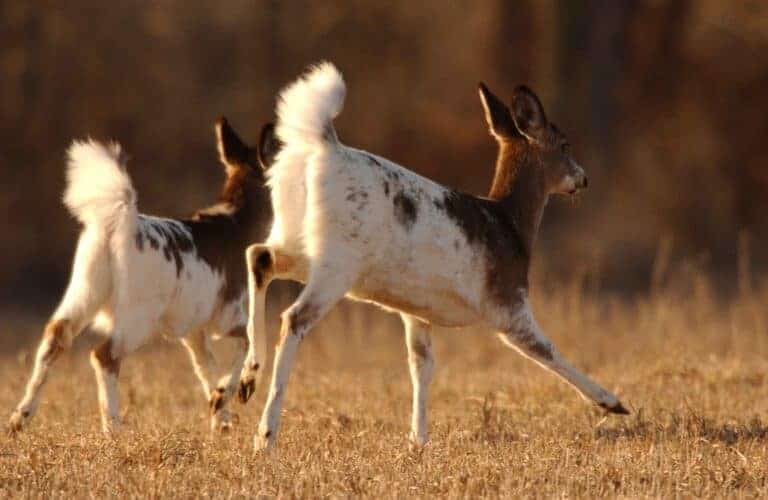
Before the actual drive starts, the hunters should be in the correct positions. When everyone is ready, the drivers will release the hound dogs and begin their push. The hounds need to pick up deer scent from the surrounding sign. After they are on the trail they will begin to loudly push deer to the hunters. The hunters also need to be very careful to not shoot one of the dogs. Keeping your dogs equipped with GPS collars that are also brightly colored will help not only keep track of them but also keep them safe. Deer drives are really a simple process, just set up a perimeter, release the hounds, and shoot deer.
RELATED POST: COMPLETE GUIDE TO AGING WHITETAIL DEER
Choosing The Breed Of Your Deer Drive Dogs
For deer drives, all you need is a dog with a good nose. The dogs should not come in contact with the deer while it is alive so there is no need for a bulky or strong dog. Just like when hunting other game, hounds are perfect for the job.
Generally, a good size pack will be 5-10 dogs, this will give you a good range and the more dogs you have the safer your pack will be. Many different types of hounds can be used for deer drives, and every veteran deer hunter will have their personal preference. Some examples of popular hound dogs used in deer drives are Beagals, Walkers, Redbones, and Plott hounds. Each of these dogs has its strengths and weaknesses so most hunters will have more than one bread in their pack.
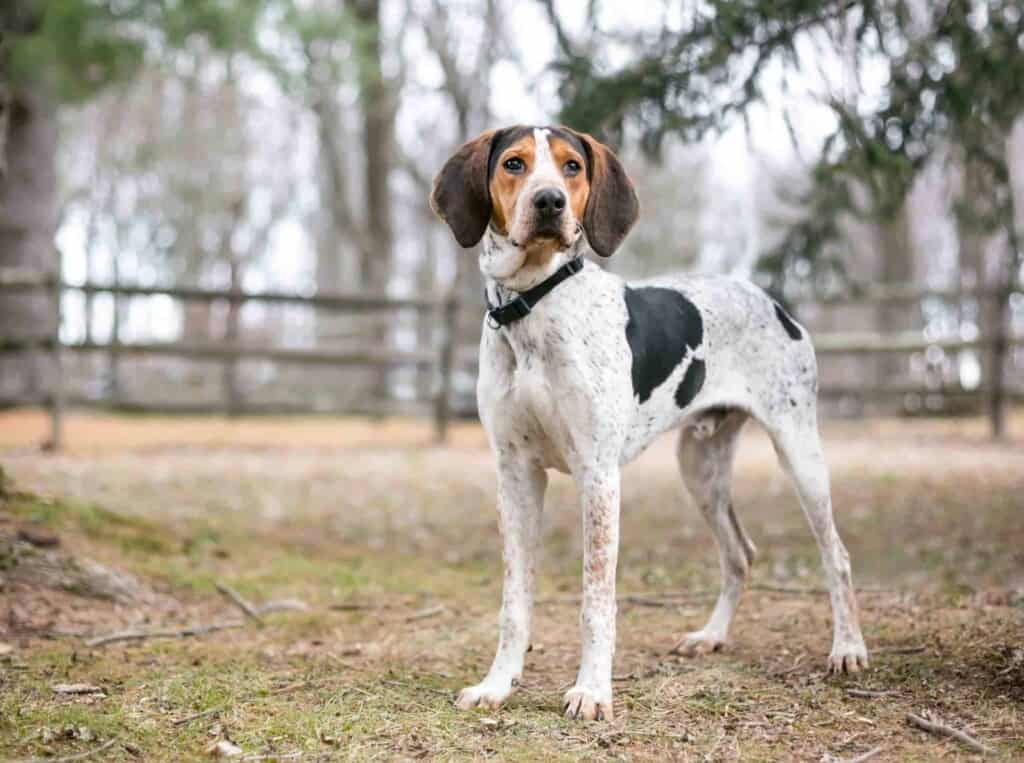
How To Train Your Dogs To Drive Deer
Before training your dog to hunt, it needs to be able to follow simple commands. Even if you are not hunting dangerous game, anything can happen in the woods and a well-behaved dog is more likely to survive. Train the dog to sit, stay, and most importantly heel. Be sure to reward good behavior, but also punish poor behavior. Training a hunting dog is different from a lap dog where you may stick with positive reinforcement only. Hunting can be dangerous so your dogs should be prepared.
Even when your dogs are young, you should be getting them used to the scent of whitetail deer. Tossing deer legs in their pens can be helpful. When you just start training a dog, take it out into the woods and let it get used to being out there. The dog should be comfortable in the woods in order to be fully proficient. Show the dog tracks and other signs of whitetail deer.
If you do see a deer, be sure to put the dog on its trail and encourage it to follow. This will give them a better idea of what you expect of them. During the off-season, you can drag a fake scent trail and guide your dogs along the trail until they find the end. Keep repeating this process until your dogs get it.
Not every dog is cut out for the job just because they are a good breed for it. If you keep trying with one dog and they just are not working out, do not be afraid to give him up and get another.
Mountain Lion/ Cougar
Cougars are one of the best natural predators in North America. They are very well equipped to take out most of the game we have. With adult males weighing over 200 pounds and being able to reach speeds of 40 mph, they are also one of the most dangerous animals to hunt in North America. Mountain Lions prey on many things but one of the most important is the whitetail deer. We like to hunt whitetails, so that makes cougars our direct competitors. Taking out cougars will lead to a higher survival rate of young deer and therefore a flourishing deer population.
How To Hunt Cougars With Dogs
To start you need to know the general area your cougar is in. You need to cover a lot of ground and look for cougar sign. The three main signs of a mountain lion are death sites, tracks, and droppings. You can pattern a cougar back to the same kill over the course of a few days if it is something large like a deer or elk. When you find a kill site you will probably find cougar tracks leading to it.
If there is snow on the ground, the tracks will be much easier to find. You can tell the sex of the mountain lion from the tracks alone. Generally, a track that is four inches wide or more is a male. Droppings also indicate that the lion is spending a favorable amount of time in the area.
In the ideal scenario, there will be fresh snow on the ground that you can then go out and find fresh tracks in the areas that you already have scouted and know carry cougars. Once you find these fresh tracks, it is time to release the hounds. The hound dogs will then track and chase the cougar until it “trees”. When a cougar “trees” that means that it just climbed a tree to escape the dogs. The dogs will then continue to bay the cougar until the hunter arrives. When you arrive at the tree, you should check the sex of the mountain lion and decide if you should harvest the animal. Then harvest the cougar.
Choosing The Breed of Your Mountain Lion Hunting Dogs
Lion hunting can be very dangerous, so you need to start off by picking the right breed of dog. A strong pick is the Rhodesian Ridgeback, they were bred to hunt African lions so a mountain lion is right up their ally. Consider other dogs like Curs, Walkers, and Plotts. Walkers are an American favorite, and very common in all hunting packs. As well as Curs and Plotts, mixing your pack up with these picks is a good start to lion hunting.
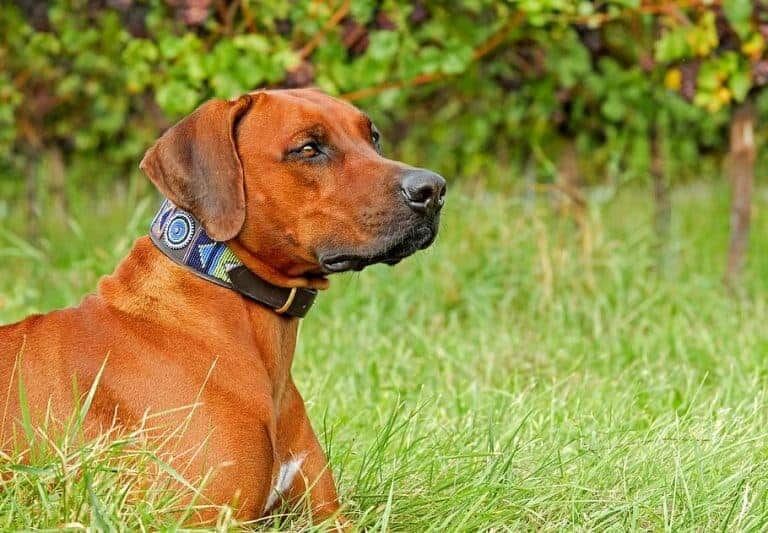
How To Train Your Dogs For Cougar Hunting
With any hunting dog, you need to lay down basic obedience training. The dogs should listen to your every command during a hunt. If they do not it could result in serious injury or death. Teaching the dog to heel can be one of the most useful commands for hunting dogs, being able to recall them to you gives you a strategic advantage over just a no holds barred chase.
Once you have picked your breeds and made up your pack, the best way to train lion dogs is to mix them in with experienced dogs. Unlike hog hunting where you can catch a young hog and let the dogs toy with it, you can not really do that with a cougar. What you can do is drag an artificial scent trail through the woods without your dogs. Then go back through it with them and encourage them along the path. This alone will not be enough to train a dog to be able to tree a cat.
This is why they are generally mixed in with older dogs. Dogs do a great job of teaching each other. The pack society is the perfect system for teaching younger dogs what they need to know in order to ensure the success of the pack.
Dog Safety
The number one priority for any hunt should be safety. This safety of you and others is the top priority. The dogs come second. Always structure your hunt in the safest way possible. Even if you do structure a safe hunt, the raw job of the dogs is to get close to dangerous animals. Their entire purpose in life is inherently dangerous. Hunting dogs are prone to injury especially when you use them often.
Make sure you have the proper equipment to keep them safe. In almost all cases you will want to get GPS collars for them. Not only does this let you know which way the hunt is going but can also help you locate injured dogs that get left behind or dogs that wander off. If you are hog hunting, make sure your catch dogs have kevlar vests to protect them from hog tusks. If a dog does get injured make sure you have the supplies to fix it, or if it is bad enough have a chosen veterinarian.
Dog injuries are part of the sport and they absolutely will happen eventually. The difference between an injured dog and a dead dog is the handler. If you know your dogs are about to go into a dangerous situation, think about it for a moment and decide if the risk is bearable. Sending dogs into a bad situation, to begin with, is a poor way to command your pack.
Thanks for reading my article about hunting with dogs. I hope you enjoyed it and learned something you didn’t already know. If you like my content, subscribe to my weekly update. If you have any other questions about dog hunting or just want to connect, feel free to email me at Patrick.Long@omegaoutdoors.net.
Resources
- Mississippi State Wild Boar Research
- Alabama Outdoor News (Deer Drive History)
- TK Hog Dogs
- PLOS Ecology Community (Wild Boar Stats)
